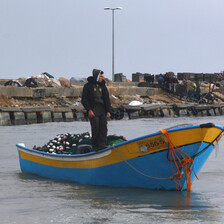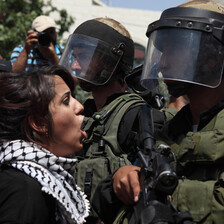The Electronic Intifada Beit Hanoun 12 July 2011

Marching towards Gaza-Israel boundary
Inter Press ServiceBEIT HANOUN, occupied Gaza Strip (IPS) - It is another sweltering morning in Gaza. Despite the heat a tenacious group of women, men and children gathers near a bombed agricultural college in Beit Hanoun for the weekly march to the “buffer zone,” the 300 meters flanking the Gaza-Israel boundary, which the Israeli authorities have declared off-limits to Palestinians.
Around a decade ago, Palestinian farmers could still access land up to fifty meters from the border. The Israeli-designated “no-go area” expanded over the years to 150 meters, then 300 meters, cutting off Palestinian farmers from their orchards, crops and grazing land.
A decade later, those orchards having been attacked with Israeli bulldozers, farmers now struggle to access land in some areas up to two kilometers from the buffer zone. This is Gaza’s more fertile land, where olive, fruit and nut trees once flourished, along with wheat, barley, rye and other crops, providing much of Gaza’s needs.
The northern part of Gaza has been particularly hard-hit over the years. And in the last three years, it is people from Gaza’s north who have led the nonviolent demonstrations against the buffer zone.
As we march the dusty kilometer to our destination 300 meters from the border — a weathered pair of Palestinian flags placed at an earlier demonstration — Khalil Nassir explains that it is the third anniversary of the weekly marches in Gaza’s north.
The popular Palestinian resistance song “Ounadikum (I call to you)” blares from Saber Zanin’s cell phone through the megaphone from which in a few minutes Zanin will broadcast a protest message against the buffer zone. Zanin and Nassir are two of the founders of Local Initiative, the community group which leads these demonstrations.
“We are a people’s resistance,” Nassir says. “We march for the farmers and the families living in the buffer zone. Many families have had their homes destroyed, their trees and crops bulldozed and are prevented from working their land. This includes many families beyond 300 meters from the border. This is the third year that we’ve marched on a weekly basis in different areas of the north.”
The group of about two dozen marches towards Erez, flanking the road roughly half a kilometer to the west along which travel those fortunate few allowed to pass through the Israeli-controlled border crossing. Straight ahead is one of the many solid concrete military towers that dot the border, from the northwest to Gaza’s southeast. It is from this tower that the Israeli soldiers usually begin shooting.
“When we first began, we only ventured up to 300 meters from the border,” Nassir says. “But slowly we started getting closer to the border. On Palestinian land. In some areas we have walked right up to the border.”
Shooting without warning
On 15 May, when nonviolent popular demonstrations marking Nakba Day (remembering the 1948 forced expulsion of about 750,000 Palestinians from their homes to make way for the state of Israel) took place in Lebanon, Syria’s Golan Heights and Gaza, this same small group of Beit Hanoun demonstrators were joined by what participants estimated to be 1,000 protesters. More than 100 protesters were injured and one teenager killed by Israeli shooting and shelling from military towers and tanks.
On 7 June, at the same small mound of earth with its two flags where we’ve paused for speeches and chants, Mohammed Kafarna, a 19 year old, was injured by Israeli-fired bullet shrapnel to his neck, thigh and abdomen.
“They opened fire without warning,” says Nassir. “Mohammed was injured right away.”
Aside from farmers and demonstrators, some of Gaza’s most desperately poor have been the victims of shooting and shelling by Israeli soldiers. The Israeli authorities categorize violence by the state’s forces as security measures.
Solidarity with Bilin
The many ruined houses near the border provide both rubble and metal. These are valuable in Gaza, given that an Israeli-imposed siege has meant that virtually no construction materials have entered the Strip for the past five years. It is in these plots of destruction that Gaza’s collectors sift, risking unexploded ordinances or attacks from Israeli soldiers.
Since 2010 alone, at least 11 Palestinian civilians have been killed in the northern Gaza border region. These included a 91-year-old farmer hit by Israeli shelling 600 meters from the border, a 64-year-old farmer shot several times in the heart while on his land 550 meters from the border, and an 18-year-old scrap collector on land 600 meters from the border.
More than thirty civilians have been injured, the majority of them impoverished scrap collectors shot in the foot or leg by Israeli soldiers along the border. A number of the injured were as young as 14 and 15.
In most of the demonstrations, international activists march alongside unarmed Palestinians, documenting the Israeli attacks. “We march whether or not we have internationals or journalists with us,” says Nassir. “Every week. We liaise with popular demonstrations in the occupied West Bank, like in Nilin and Bilin.”
The village of Bilin has, after six years of nonviolent demonstrations achieved the minor victory of having Israel’s wall moved slightly back, returning roughly 150 acres of land to the village, which still waits for the return of a further 330 acres.
Here in Beit Hanoun, Zanin urges us to move back, away from the buffer zone. Israeli soldiers and military jeeps have appeared and the protest leaders want to avoid further casualties of Israeli state violence.
“We are aware there is great danger in this area,” says a protester. “And they do regularly shoot at us. We don’t want casualties but we will march on Palestinian land, for the families and farmers who can’t access their land.”
All rights reserved, IPS - Inter Press Service (2011). Total or partial publication, retransmission or sale forbidden.





